Earlier this year, I picked up a zelkova in need of repotting. I cleared out the old soil and let the tree grow freely. Now that it’s showing signs of great health, I thought I’d start working on the branches.
Before getting to work, I thought about where the front might be. I didn’t find any obvious candidates, so I defoliated the tree as this can make it easier to see the branch structure.
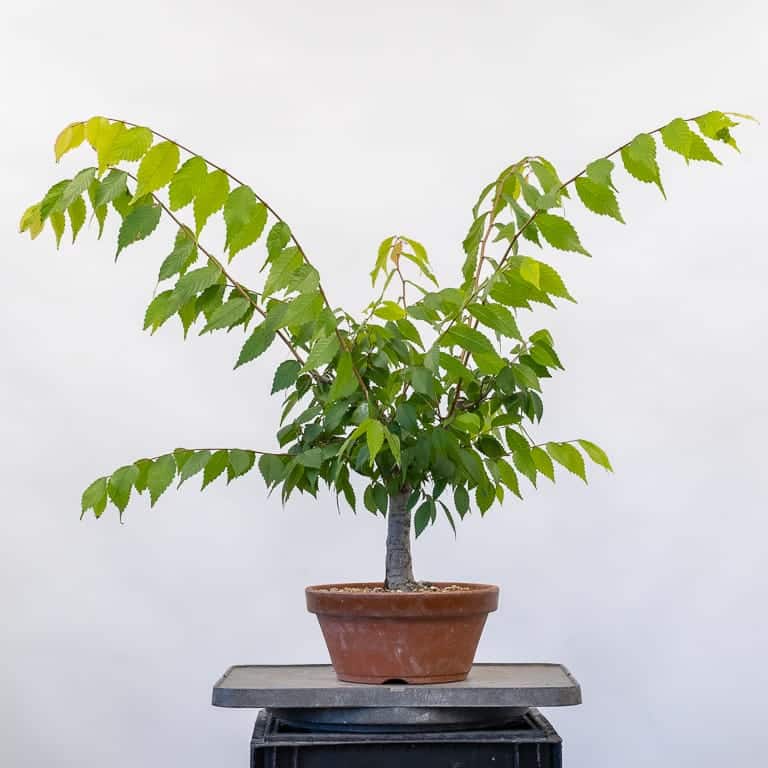
Healthy zelkova foliage
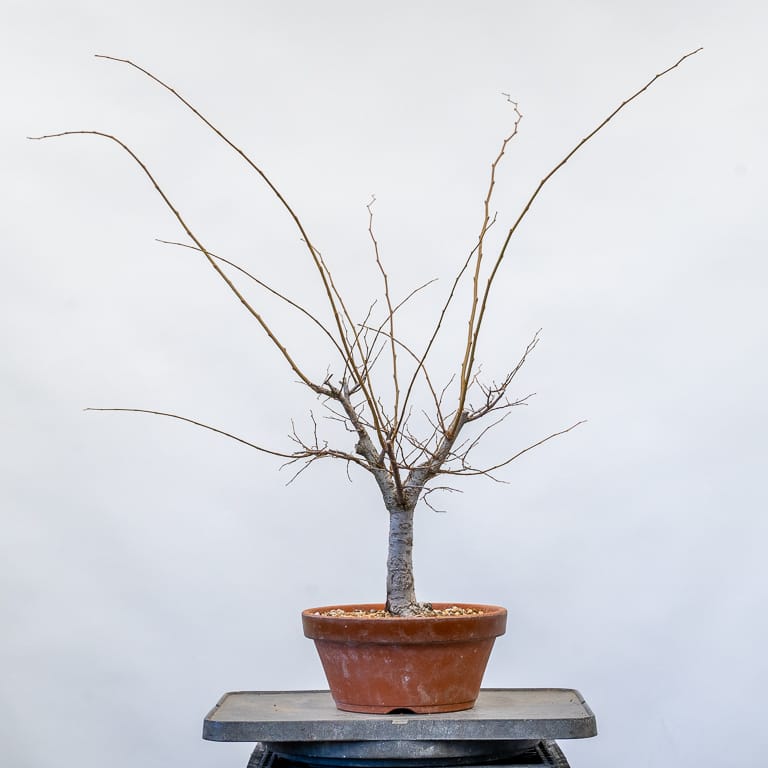
After removing the leaves
I turned the tree around and still didn’t find a satisfying front. I thought pruning might help so I shortened the longest branches.
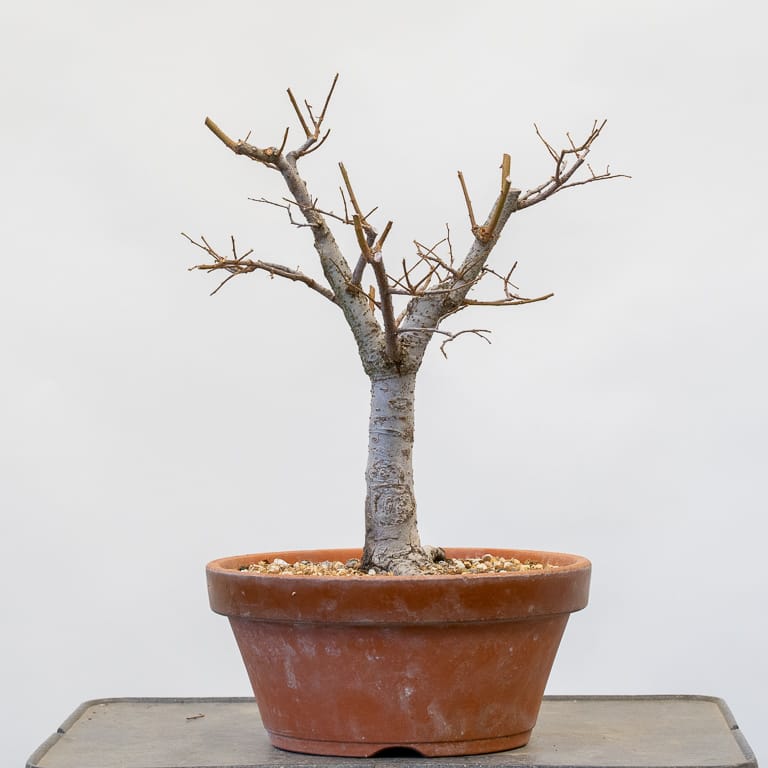
After pruning
This didn’t help much either so I thought I’d see if wiring the tree made a difference. It did – I liked the way the tree looked wired – but I wasn’t much closer to finding a front.
Here are a few views from different sides of the trunk. Do any look like they might work for a front?
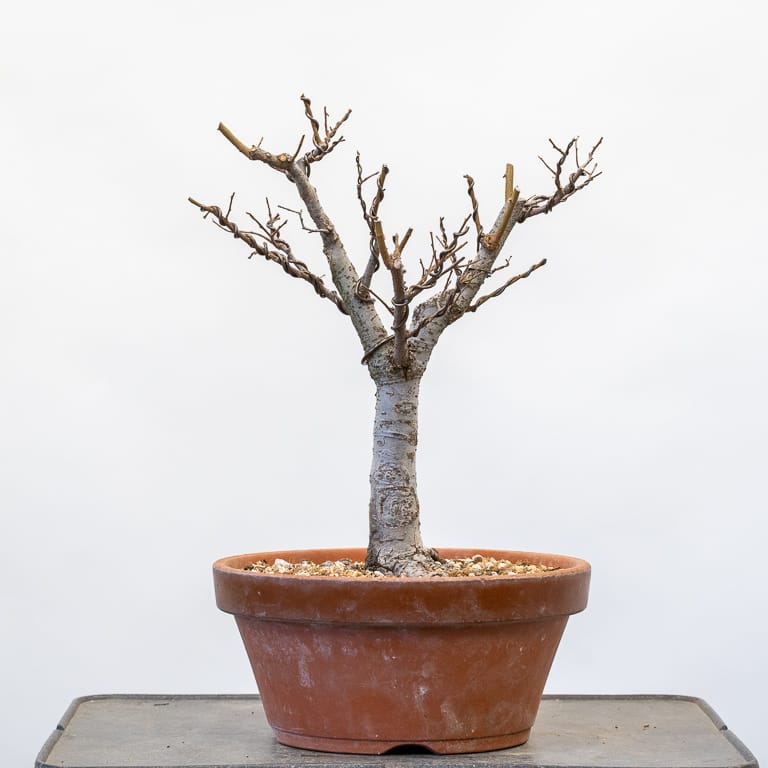
After wiring (11″) – option #1
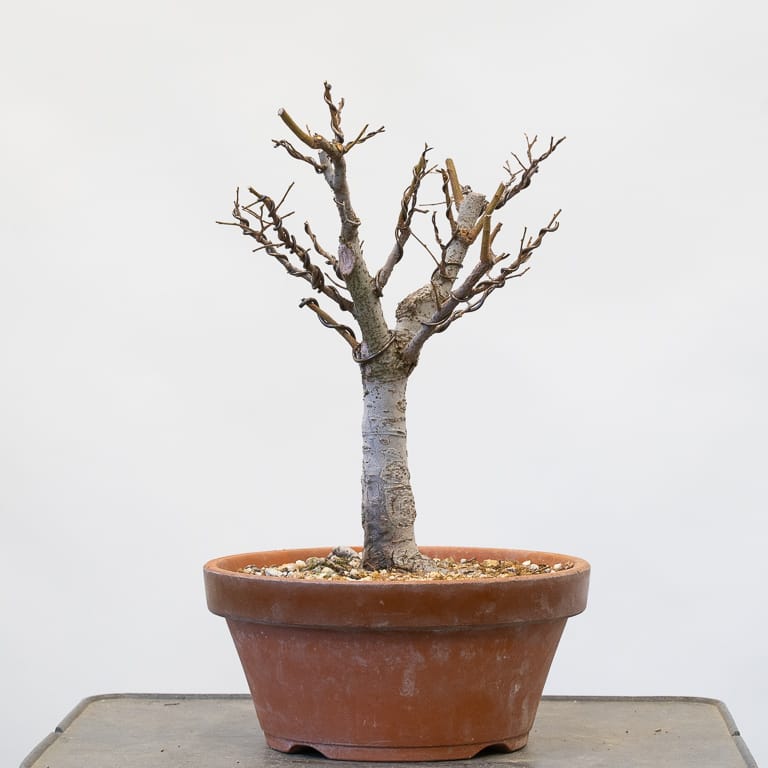
Option #2
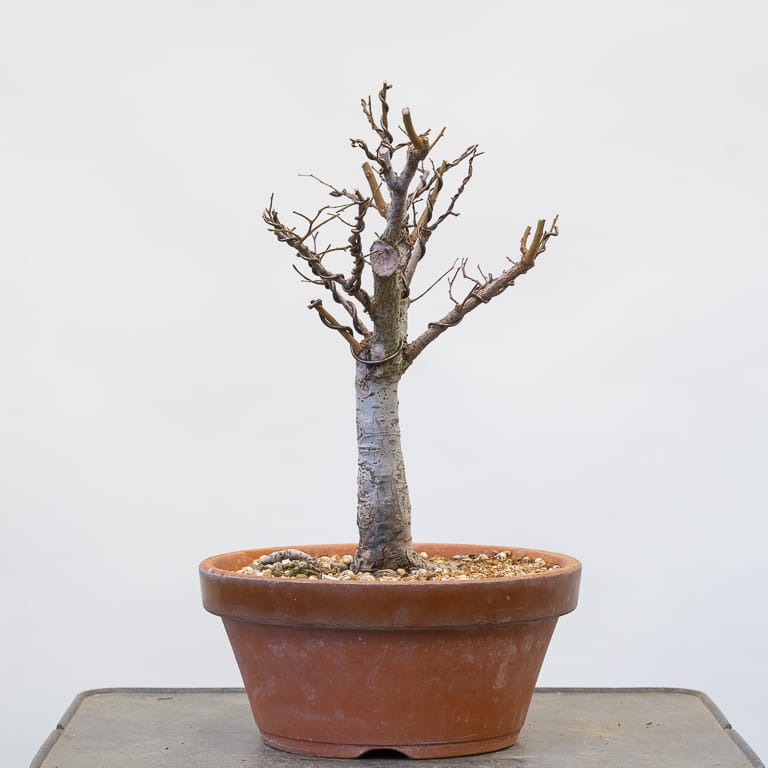
Option #3
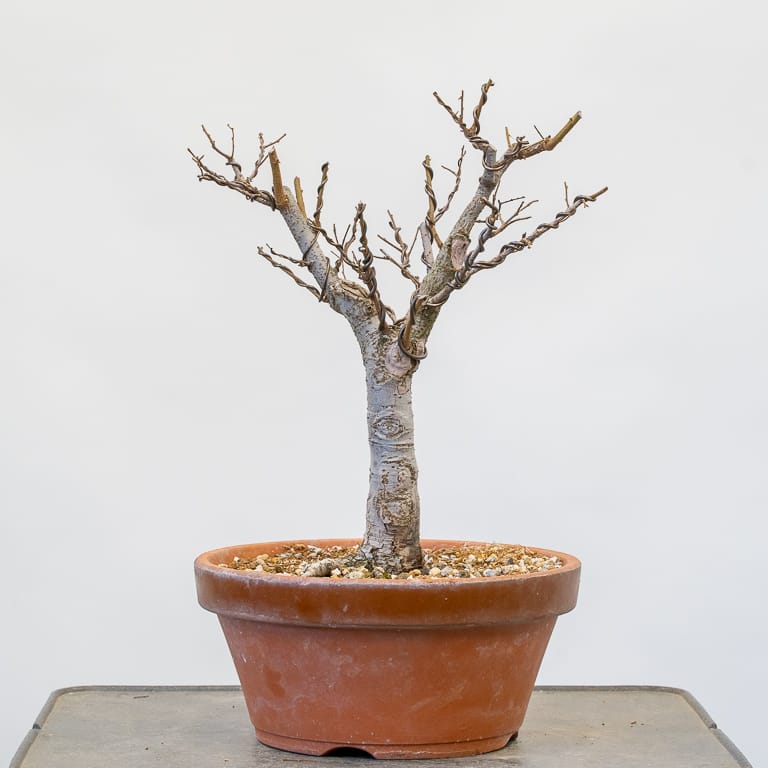
Option #4
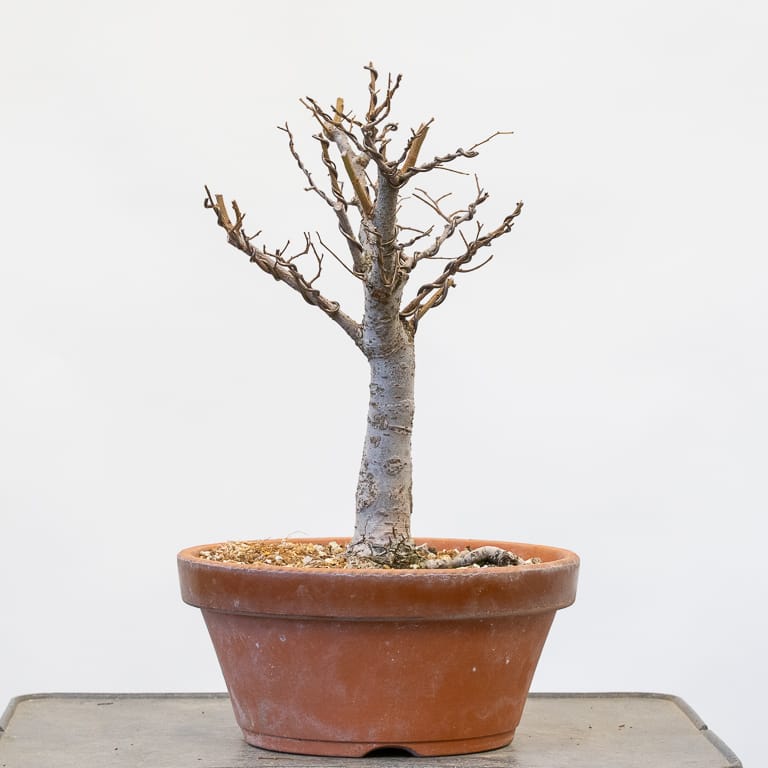
Option #5
I plan to let the tree grow out over summer and then prune again in fall. The new growth might help me find a good front, and if not, I can continue making improvements until it’s time to move the tree into a bonsai pot.
Subscribe to Bonsai Tonight
New Posts Delivered Every Tuesday and Friday
Mateusz says
Hi Jonas! For me the best front is option #4. Nice angle in between the main branches.
Btw. I’m reading your blog with great curiosity and I’m learning a lot from you! You’re doing a great job!
Greetings from Poland. 🙂
Jonas Dupuich says
Thanks so much Mateusz – I appreciate it!
Richard Dorfman says
Hi Jonas. Interesting tree.
To my eyes #2 offers the best front, with #1 a close second. The branching structure seems too tight in #3 and #5. In #4 the tree too closely resembles the letter “Y”. Wouldn’t decide between #2 and #1 until seeing the tree leafed out.
Douglas Adams says
I agree that options 1 and 2 appear the best to me and the decision will become easier as it leafs out again.
Jonas Dupuich says
Thanks, Richard – I’m mostly focusing on getting the tree healthy this year and am considering some bigger cuts next year. The tree was weak coming out of winter and I want to make sure it’s growing well before making significant reductions. If I go that route, I’d be left with something resembling a Y, albeit a shorter Y.
Andrei says
What about the nebari? I’d suggest that you pick the front where nebari looks the best. Branches can be developed later. Especially when the tree sprouts as readily as you showed us.
A.
Jonas Dupuich says
Great point Andrej – the only reason I’m not focusing on the roots is that I may layer the tree if I find a front that doesn’t line up with the side that has the best roots.
Lani says
Hi Jonas. I’m liking #4. Are you making it a broom style because the primary branches start at the same junction on the trunk?
Jonas Dupuich says
Hi, Lani! I’m thinking broom-style because the base of the trunk is straight. There are different approaches to broom-style bonsai, including one approach that begins with a single split from 1 to 2 and then repeats the pattern again and again. This version of broom-style is tricky, but it might be a good fit as it doesn’t have a central leader that tapers to a fine point, and the multiple branches that split from the main trunk are very different in size.
The alternative is to go with a more informal approach to broom-style and focus on branch angles instead of the precise pattern in which the branches divide.
Glenda says
My choice is # 4.
# 1 has that small upward branch right in the middle; distracting,
# 2 my second choice. Scar on upper 1/3 of tree where a large branch has been removed. Good base.
# 3; Also has the large scar very visible. Base isn’t as good because there is the exposed root on the left . (Just my opinion and the way my eye sees it)
# 5; Exposed root on the right also distracting
Over all, this tree is a keeper and the so called faults are very minimal. I like it!
Jonas Dupuich says
Thanks, Glenda! I’m curious if your selections would change if you were free to remove or shorten any of the existing branches.
Glenda says
Hi, again Jonas. By turning the tree in view #1 that distracting branch no longer is a problem. View # 3 has a straight up branch to the left. It’s connected to the 3rd branch from the bottom. I think you could eliminate it since it’s parallel to the main trunk. It is right next to the large scar which directs my eye to it. I do like the way you have placed the branch spread. As the tree grows those scars will callous over and disappear, solving the problem. This tree is a great example of the broom style. Do you find it difficult to style a broom style? I do…
Jonas Dupuich says
Thanks, Glenda – and yes, I find the style challenging too! Bonsai is tricky when we expect branches to grow in specific places and maintain certain sizes.
That said, broom style trees I’d worked on a few years ago felt challenging and flawed at the time, but looking back at photos, it seems like they were on the right track. I think growing more of them will make the process feel, and the results look, much better!
Nicky Ducommun says
I’d go with option #4 but with #2 a close second place. Basing this on what little nebari there is and liking the branch spread on those choices.
Terence Krista says
I vote 2 or 4, but is there really a front in broom style?
Jonas Dupuich says
There is a front is broom-style bonsai, but it’s not always dramatically different from the other sides.
Iris says
Good day!
Regarding a front, I thought broom style is “fluid”, round, without a specific front. Seeing that bonsai is not a static practice, place it in a nice round pot. It can then be allowed to change, giving you more time and options to decide on a front.
Jonas Dupuich says
Hi Iris! I’m glad it’s currently in a round pot as it makes it easy to be flexible with the front. I’m optimistic some good options to become clear in 1-2 years, and if not, I have some more pruning to do.
Mac McAtee says
No matter what is outlined above you still have a sling shot. I’d cut one of the large branches completely off and regrow some finer branching in the area where the cut scar would be. It might take several years but eventually you’d end up with something much better than any of the options if you don’t cut one arm of the Y off.
Zack Clayton says
My choice with the current branch structure is 1 and 2, then 4.
3 has the ugly scar prominent and 5 has the weird bend at the main trunk split.
What do the hidden roots tell you?
I am looking forward to a development series on this as I don’t know of any on broom style. although there are some one-off articles that don’t really connect any dots.
Jonas Dupuich says
The roots aren’t good from any side as they are uneven – I plan to layer the tree in a year or two. And that makes sense about the articles – I haven’t seen many that progress over longer periods of time either. Will see what I can do!